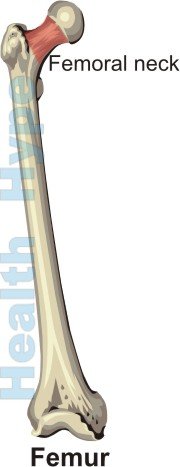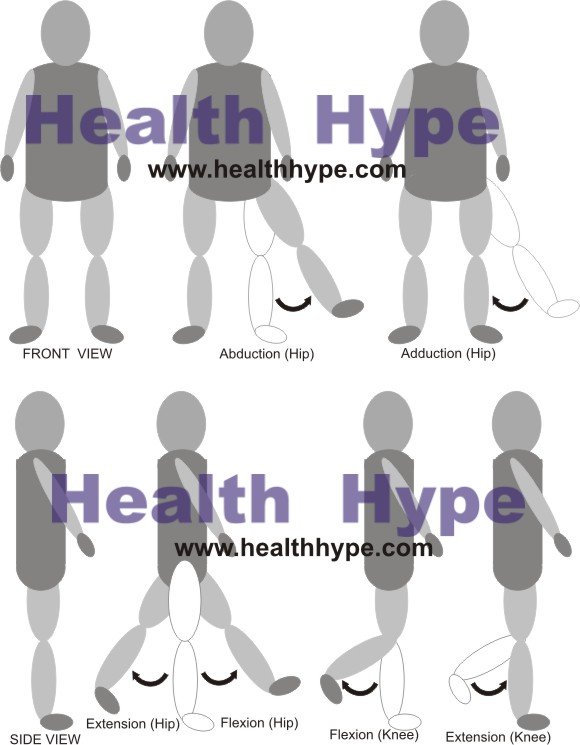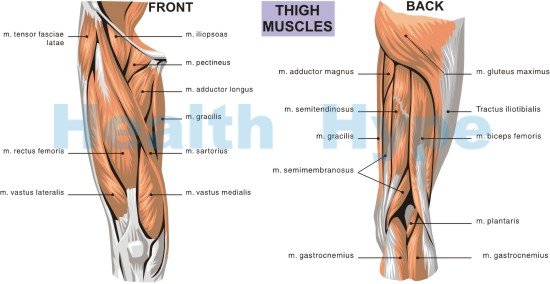Thigh Pain Symptoms with Movement and Causes of Pain in Thighs
What is thigh pain?
Thigh pain is any discomfort, soreness or pain in the area lying between the pelvis and knee. In most instances it is due to muscle and tendon pain, but can be associated with any disease or disorder of the ligaments, bone, joints, blood vessels or nerves in the thigh. Sometimes the problem may originate from the pelvis, groin or lower back and radiate to the thigh or cause referred pain to the thigh.
The thigh is the part of the lower limb between the pelvis and a knee. It is mainly a muscular part of the body with a single long bone known as the femur. The thigh carries the weight of the upper body, transfers it down to the lower leg and feet, and also aids with mobility. The muscles of the thigh can be divided into three separate compartments, each of which has its own blood and nerve supply. It has some of the largest muscles of the body, which aid with abduction and adduction, flexion and extension at the hip and knee joint.
Symptoms of thigh pain
Pain in the thigh may be felt in the front (anterior), back (posterior), outer thigh (lateral) or inner thigh (medial). The different causes may lead to thigh pain in one side of the thigh more than the other. Thigh pain may occur on its own or be accompanied by other local symptoms such as :
- Swelling of the thigh
- Tenderness of the thigh
- Difficulty with the movements facilitated by the thigh muscles due to muscle weakness or paralysis
- Redness of the skin
- Heat over the affected part
- Deformity of the thigh
- Bleeding from the thigh
- Muscle cramps
- Joint swelling and joint pain
- Limping
- Grating or popping sounds from the hip or knee joint
- Numbness and tingling of the leg and feet
Thigh pain is a symptom of some underlying disorder within the thigh or surrounding areas like the knee and lower leg or hip and pelvis. Due to its close proximity, pain within the groin and external genitalia may also cause thigh pain in some instances. Therefore other symptoms of these organs or systems may provide a better indication of thigh pain.
Thigh Pain with Movement
Most cases of thigh pain are due to muscle and tendon strain. In these instances, the pain may only occur or worsen with certain movements of the thigh and lower leg which may provide a better indication of the muscles and tendons that are affected.
- Adduction of the thigh occurs at the hip joint where the thigh moved vertically towards the midline. The muscles responsible for this action is known as the adductors of the thigh and includes the adductor longus, adductor brevis, adductor magnus and gracilis muscles. Other muscles may also play a role in stabilizing the hip joint during this movement.
- Abduction of the thigh also occurs at the hip joint where the thigh moves away from the midline in a vertical plane. The muscles responsible for this action includes the sartorius muscle of the thigh and the gluteus medius and gluteus minimus muscles of the buttock.
- Flexion can occur at the hip or at the knee joint. Hip flexion is where the thigh moves forward in a horizontal plane. Knee flexion is where the lower limb straightens at the knee joint.
- Extension can occur at the hip or at the knee joint. Hip extension is where the thigh moves backwards in a horizontal plane. Knee extension is where the lower leg bends at the knee joint bringing it up against the back of the thigh in a horizontal plane. This involves both muscles in the pie and the lower deck.
Causes of thigh pain
The causes of thigh pain have been discussed in terms of the specific structure within the thigh that has been affected like the muscles, ligaments, joints, bones, nerves and blood vessels. Other conditions which may affect multiple structures simultaneously has been discussed under diseases and disorders.
Muscles and tendons
The most common causes of thigh pain is related to physical activity resulting in strain and sometimes injury of the muscles (commonly referred to as a pulled muscle) and tendons (tendonitis). It may also lead to muscle cramps, commonly referred to as Charley horse, which is often associated with overuse and strain of the thigh muscles. This is more likely to occur in a person who is not physically fit and undertakes strenuous and prolonged activities like hiking, swimming, aerobics or dancing. Even moderate activity without first stretching can lead to a pulled muscle or tendon strain. Muscle strain and cramping may also simultaneously affect the buttock and lower leg muscles. In severe cases, there may be muscle tears. Some of the more commonly affected muscles and its tendons are the :
- Hamstrings – back of the thigh
- Quadriceps – front of the thigh
- Adductors – inside of the thigh, often accompanied with groin pain
Refer to the thigh muscles pictures for more information.
Ligaments
The ligaments are thick bands of connective tissue that provide support and stability particularly during movement. However, it can be stretched or torn with overuse or injury. This is known as a sprain. It may be associated with ligaments of the thigh or also of the hip and knee. Some ligaments that may be sprained includes the :
- Anterior or posterior cruciate ligaments – knee
- Inguinal ligament (inguinal strain) – groin
- Medial collateral ligament – knee
Hip and knee joints
Inflammation and injury of the hip and knee joints can both cause thigh pain either towards the upper or lower part of the thigh respectively. This may arise with conditions such as :
- Arthritis – inflammation of the joint and its lining.
- Arthrosis – degeneration of the joint cartilage with wear and tear.
- Meniscus tear – tear in the joint cartilage.
Bone
Bone pain of the thigh is more likely to arise from the femur, although the pelvic girdle, patella and upper end of the leg bones may also be involved.
- Fractures of the femur, most likely to affect the femoral neck with major injuries.
- Stress fractures with minor injury or overuse of the femur.
- Osteomyelitis which is an infection of the bone.
- Cancer of the femur is most often as a result of metastasis (spread) of cancer from a distant site and very rarely originates in the femur.
- Bone mineralization disorders like osteomalacia (rickets in children) or osteoporosis.
Nerves
Nerves run through the thigh either supplying structures within the thigh or passing through to the lower leg and feet. Various conditions may give rise to nerve pain in the thigh also involving the lower back, pelvis and/or lower leg and feet. Some of these conditions includes :
- Sciatica is a condition caused by injury of the sciatic nerve or compression of its root at the spinal cord.
- Meralgia paresthetic (burning thigh pain) due to injury or compression of the femoral cutaneous nerve.
- Peripheral neuropathy is any injury or damage to the nerves supplying the lower limb often associated with diabetes mellitus (diabetic neuropathy).
Blood vessels
Arteries supply oxygen-rich blood to the thigh and lower leg and veins drain away oxygen deficient blood. This mainly happens through the femoral artery and vein. Obstruction or damage to the blood vessels may result in pain emanating from the vessel itself or the tissue of the thigh associated with tissue damage due to reduced oxygen and nutrient supply.
- Peripheral arterial disease (PAD) occurs as a result of reduced oxygen rich blood flow to the lower limb.
- Varicose veins arises with abnormal dilatation of the superficial veins of the leg causing it to distend and hamper blood flow back to the heart. *
- Deep vein thrombosis (DVT) is the presence of a clot in the deep veins of the leg associated with poor venous circulation. *
* These conditions are discussed further under venous insufficiency of the legs.
Diseases and disorders
A number of conditions can arise in the thigh that affects more than one structure simultaneously. This includes :
- Injuries leading to contusions or lacerations.
- Compartment syndrome where build up of pressure within a compartment, due to swelling or blood accumulation, compresses the muscles, blood vessels and nerves.
- Cellulitis which is an infection of the skin and underlying tissue associated mainly with bacterial infections.
- Femoral hernia where a part of the abdominal organs (usually the small intestine) pushes through a weakening in the abdominal wall near the upper thigh.
- Groin pain due to any cause may lead to pain in the inner or front of the thigh.
- Fibromyalgia is a chronic condition marked by widespread muscular pain and tenderness that occurs for unknown reasons. There is no evident injury of the muscle itself.





